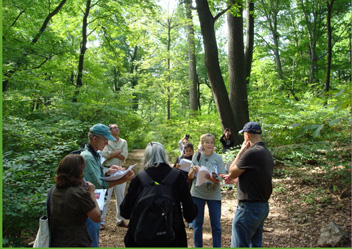Forest Alert: Tree Watchers at Work
Posted in Behind the Scenes, Science on September 12 2011, by Sandy Wolkenberg
Ed. note: Sandy Wolkenberg is a Citizen Scientist who has been working in the Thain Family Forest for three and a half years. Over the course of a week on Plant Talk, Sandy will share a five-part series of posts on The New York Botanical Garden’s Citizen Scientist Tree Phenology Program. If Sandy’s experiences motivate you to want to know more about becoming a Citizen Scientist, check out the Garden’s Volunteer Program page.
On June 16, 2011, volunteers in the Citizen Science Tree Phenology program received the following email from Jessica Arcate Schuler, Manager of the Thain Family Forest:
Hi Everyone!
I hope you are all enjoying this late spring, soon-to-be summer. I have an update on the Spicebush Trail. Unfortunately, Tuliptree #98 had to be removed this week. As many of you know, it has been struggling these past two years as a result of a severe lightning strike in summer 2009. We were hoping that it would come out of winter okay, however, it did not. The arborists felled the tree on Tuesday. I just counted the rings and it seems to be just under 150 years old. We will plan to find a healthier tuliptree to add to the project starting in spring 2012 to replace this lost tree on the Spicebush Trail. In the meantime, just ignore #98 on your datasheets for the remainder of the season.
Alas! How shall we ignore Tuliptree #98? Citizen Science Phenologists who chronicle the Spicebush Trail have lost an old friend–a tree friend, to be sure–but a friend we have been observing since the Citizen Science Tree Phenology program began in 2008. This program grew out of a long-term phenology study started by Dr. Charles Peters with the help of students and Garden staff. In 2008, the Citizen Science Phenology Program was initiated with an email to Docents from Volunteer Services. A small, curious group of Docents met to hear about this intriguing new venture. The program was quickly opened to all volunteers and soon training sessions and on-site support followed.

“Phenology” (surely they have misspelled the word and mean “Phrenology” – but no, the word is indeed “phenology”) is defined in the training literature as, “the timing of life cycles such as flowering, leafing, reproduction, and fruiting.” Citizen Science volunteers observe specific trees in the Forest, recording data about these trees, and inputting this data into the USA National Phenology Network database. “These entries will provide baseline data for monitoring climate change and its impact on plants.” The goals of the Citizen Scientist Phenology Program are clearly defined:
– To train individuals how to be Citizen Scientists who will collect plant phenology data and who can pass on these skills in their own community
– To make The New York Botanical Garden the central location and resource for Citizen Science in the metropolitan area
– To contribute data to the USA National Phenology Network database
– To collect some unique data for The New York Botanical Garden
Citizen Scientist Phenology Program volunteers receive intensive training in a wide area of subjects ranging from basic botany, trail locations, tree identification and location, and data entry at the USA National Phenology Network database. Many future phenologists learn to use binoculars more effectively and can ultimately measure their success by reaching high numbers on the “stiff neck” scale. This is achieved by scanning very tall emergent Forest trees–tulip poplars, sweetgums, red and black oaks, hickories, red maples, white ashes, black cherries, and American beeches–for extended periods of time. Volunteers attend guided “field training” walks along the Spicebush Trail learning where and how to find the specific trees that had been marked for the Phenology program and how to enter data on data sheets.


What a wonderful introduction to Phenology! After reading this, I suspect that a lot of folks will want to join up! I’m looking forward to reading the next four installments on this subject! Thanks, Sandy!